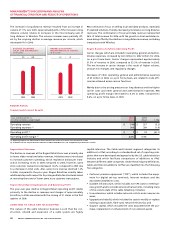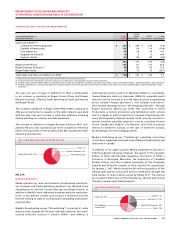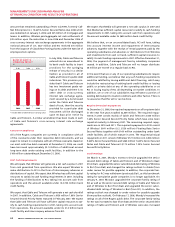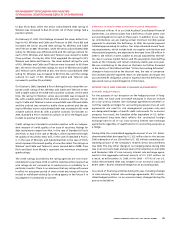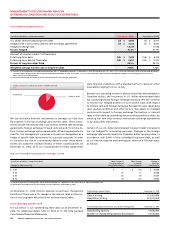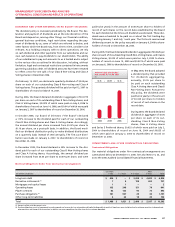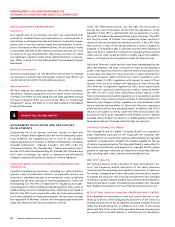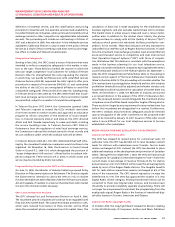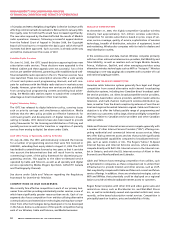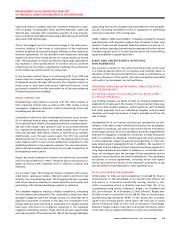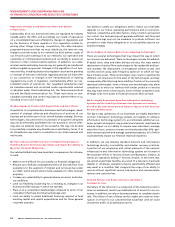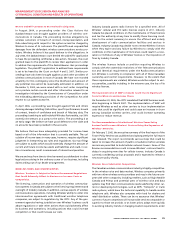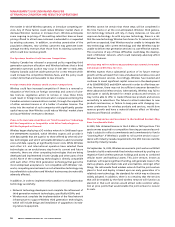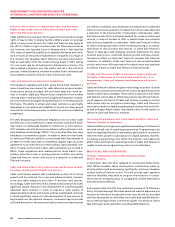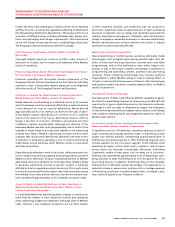Rogers 2006 Annual Report Download - page 53
Download and view the complete annual report
Please find page 53 of the 2006 Rogers annual report below. You can navigate through the pages in the report by either clicking on the pages listed below, or by using the keyword search tool below to find specific information within the annual report.
49
RO GER S CO MMU NIC AT ION S IN C . 20 0 6 ANN UA L RE POR T
MANAGEMENT’S DISCUSSION AND ANALYSIS
OF FINANCIAL CONDITION AND RESULTS OF OPERATIONS
The chief executive officer and 80% of the members of the Board
of Directors of the operating licencee must be resident Canadians.
There are no restrictions on the number of non-voting shares that
may be held by non-Canadians at either the holding-company or
licencee-company level. The CRTC has the jurisdiction to determine
as a question of fact whether a given licencee is controlled by non-
Canadians.
Pursuant to the Telecommunications Act and associated regula-
tions, up to 20% of the voting shares of a Canadian carrier, such as
Wireless, and up to 331/3% of the voting shares of a parent company,
such as ourselves, may be held by non-Canadians, provided that
neither the Canadian carrier nor its parent is otherwise controlled
in fact by non-Canadians. Similar restrictions are contained in the
Radiocommunication Act and associated regulations.
In April 2003, the House of Commons Industry Committee released a
report calling for the removal of foreign ownership restrictions for
telecommunications carriers and broadcasting distribution under-
takings. In June 2003, the House of Commons Heritage Committee
released a report which opposed the Industry Committee’s recom-
mendation. The Cabinet responded to the Industry Committee
report in September 2003 and to the Heritage Committee report in
November 2003. The government announced that officials from the
Industry and Heritage departments will convene to reconcile the
two positions. We are not aware of any further legislative initiatives
related to a reduction or change in foreign ownership restrictions,
although the matter continues to be discussed in the media.
TELECOMMUNICATIONS POLICY REPORT
On March 22, 2006, the report of the Telecommunications Policy
Review Panel was released. The Panel was asked by the previous
government to study Canadian telecommunications policy to make
recommendations to improve the regulatory environment, expand
broadband services to remote locations and further the deployment
of information and communications technology in Canada. The
report generally recommended greater reliance on market forces
and a reduction in government regulation. The report recommends
continued regulation of the incumbent wireline telephone compa-
nies in circumstances where they possess significant market power.
We believe that such continued regulation is important to protect
new entrants such as Cable and Telecom from anticompetitive
conduct by incumbent providers until such time as competition is
established. The report also recommends limiting the incumbent
phone companies’ unbundled wholesale facilities that would be
available to competitive providers on a wholesale basis. The report
recommends that “essential” facilities should continue to be made
available and that non-essential facilities should be available for a
transition period of three to five years. The report also recommends
transitioning radio spectrum regulation from Industry Canada to the
CRTC, after Industry Canada completes a spectrum policy review that
will consider various issues such as spectrum licence fees and stream-
lining the spectrum licencing process. Upon receiving the panel’s
report, the Minister of Industry stated that he would review the
report and that any steps towards implementation of the report’s
recommendations would follow such review.
Additional discussion of regulatory matters and recent developments
specific to the Wireless, Cable and Telecom, and Media segments
follows.
WIRELESS REGUL ATION AND REGULATORY DEVELOPMENTS
Spectrum Licence Issues
Late in 2003, Industry Canada released a policy document regarding
a number of spectrum issues, including a discussion on the existing
spectrum cap, spectrum allocations for 3G networks and possible
timing of a 3G spectrum auction. Industry Canada proposed a pos-
sible 3G spectrum auction date of 2005 to 2006 for this spectrum. The
Federal Communications Commission (“FCC”) in the United States
concluded their auction of Advanced Wireless Services (“AWS”) spec-
trum, in September 2006, raising $1.4 billion. 90 MHz of spectrum was
auctioned. In February 2007, Industry Canada released a consultation
document regarding an auction for the same 90 MHz of spectrum.
Comments can be submitted by May 25, 2007 with reply comments
submitted by June 27, 2007. An auction is expected in early 2008.
On August 27, 2004, Industry Canada rescinded the cap on owner-
ship of mobile spectrum. Up to that time, Canadian carriers were
limited to a maximum of 55 megahertz of mobile spectrum. After a
public consultation earlier in 2004 as to whether the cap should be
maintained, removed or increased, Industry Canada advised that the
cap would be removed, effective immediately. In the February 2007
Consultation document Industry Canada questioned whether an
auction cap or a “set-aside” of spectrum or some other mechanism
would be appropriate to attract new entrants to Canada’s wireless
industry.
Fixed Wireless Spec t rum Auction
On February 9, 2004, Industry Canada commenced an auction for
one block of 30 megahertz of spectrum in the 2300 MHz band as
well as three blocks of 50 megahertz of spectrum and one block of
25 megahertz of spectrum in the 3500 MHz band. The auction was
completed on February 16, 2004. There were over 172 geographic
licence areas in Canada for each available block. Licencees have flex-
ibility in determining the services to be offered and the technologies
to be deployed in the spectrum. Industry Canada expected that the
spectrum will be used for point-to-point or point-to-multi-point
broadband services. Wireless participated in this spectrum auction
and, as a result, acquired 33 blocks of spectrum in various licence
areas for an aggregate bid price of $5.9 million.
Industry Canada initiated another auction process to make avail-
able the blocks of spectrum that did not sell in the February 2004
process. Parties were able to identify those blocks that they were
interested in, and if there were no other parties expressing interest
in those blocks, they were the successful party. In this process,
Wireless obtained an additional nine licences for a cost of $0.2 mil-
lion. The remaining licences were auctioned commencing January 10,
2005, and Wireless was successful in supplementing its spectrum
holdings from 2004 with a further 40 licences at a cost of $4.8 million.
See also below under “Wireless’ Expansion and Investment in the
Inukshuk Business May Have Considerable Risks”.
Inu kshuk
On March 31, 2006, Industry Canada approved the transfer of
Wireless’ Inukshuk licence to Inukshuk Wireless Partnership, a
Rogers-Bell joint venture. New licence terms were also issued. These
licence terms require Inukshuk to return spectrum that it is not using
as of December 31, 2009. At the same time as the licence was issued,



